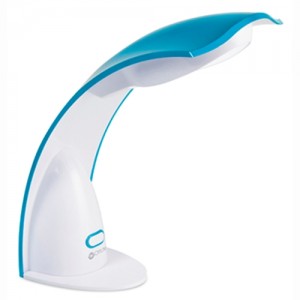If you missed our first two installments, click here for
Part One, and here for
Part Two.
Part 3: OttLite designs a better light bulb
So now we know the 3 characteristics of a perfect light bulb:
- • Good s/p ratio, including scotopically rich area of the spectrum
- • high CRi (true-white light)
- • CCT close to natural sunlight
All compact fluorescent bulbs (CFL) have a CCT close to natural sunlight, but they do not always have a true-white light. And very few of them include the scotopically rich area of the visual sensitivity spectrum.
It’s All About the Phosphors
When a fluorescent light bulb is powered on, electricity excites mercury vapor within the lamp. The excited mercury atoms produce ultraviolet light, which causes the phosphors to emit light. The phosphors are what determine a fluorescent light’s particular s/p ratio and CRi.
In much the same way that an artist mixes colors to achieve a desired hue, OttLite engineers mixed phosphors in specific proportions to achieve a desired light color. We use “rare earth phosphors” to create a unique blend that creates these 3 perfect light bulb values.
Consumer Question: Did You Say Mercury?
There is a trace amount, less than 5 milligrams, of mercury in all fluorescent bulbs. This amount is so minimal it is not considered dangerous. In fact, according to the Enviromental Protection Agenecy, one CFL contains 100 times
less mercury than the mercury found in a dental amalgam filling or old-style glass thermometer.
Why Our Bulbs Are Better
Incandescent lighting contains virtually no ultraviolet, lacks the scotopic end of the spectrum, and produces its maximum energy in the infrared wavelengths invisible to the human eye. These wavelengths produce a lot of heat, though. So they’re less visually-efficient and less energy-efficient.
CFLs produce the majority of their energy in the visibility range of the spectrum, wasting very little energy in the infrared range. OttLite CFLs are different because they include the range on the spectrum that is scotopically rich, activating the rods in your eyes. This means people can read better under our lights.
Our CRi is 90 or better, which means people have better color acuity when viewing colors under our lights.
But Why Is It Called 508?
On a Chromaticity Diagram, our lights have a dominant wavelength of 508. A Chromaticity Diagram allows all colors to be defined as a weighted sum of the three primary colors. White light is located in the center of the diagram. As the wavelengths increase in nanometers, the light’s color changes. The theory is that this 508 dominant wavelength goes even further in enriching scotopic sensitivity. 508 nicely sums up what makes our lights so unique…and by unique, I mean superior:
CRi of 90 or better
CCT between 5000 and 5800K
508 dominant wavelength
 In Conclusion:
What is 508® Technology?
In Conclusion:
What is 508® Technology?
508 is the dominant wavelength in our proprietary illumination, created by our unique blend of rare-earth phosphors.
What that means…
More details: Scotopic-enriched light allows you to see details more clearly.
True color: A high CRi (color rendering index) lets you see colors as they truly are.
Less eyestrain: Better lighting, not brighter, means you’ll see more and squint less.
You're welcome.
3 Comments
You need to
login to comment.
-
Marissa
•
12 years 101 days ago
Hi Tracy. All of our bulbs DO have the 508 technology with the exception of our LED products. Unless the product has LED in its name it will be 508 :) Thanks for the great question!
-
Tracy
•
12 years 105 days ago
I love the HD quality of the 508 bulbs and all of the inherent benefits that go along with this technology, but I do have one question: Do ALL of your bulbs have the 508 illumination features????
Thanks for clarifying this for me - I'm just a little confused on this issue :S
Tracy
-
Lorri
•
12 years 129 days ago
I have a question. Is this the type of light I need for SAD or is it just meant to be best for things like sewing projects?